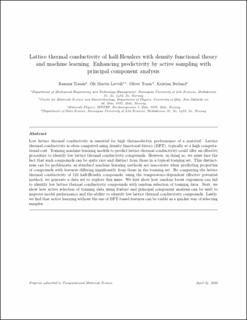Lattice thermal conductivity of half-Heuslers with density functional theory and machine learning: Enhancing predictivity by active sampling with principal component analysis
Peer reviewed, Journal article
Submitted version

Åpne
Permanent lenke
https://hdl.handle.net/11250/2993526Utgivelsesdato
2021Metadata
Vis full innførselSamlinger
Sammendrag
Low lattice thermal conductivity is essential for high thermoelectric performance of a material. Lattice thermal conductivity is often computed using density functional theory (DFT), typically at a high computational cost. Training machine learning models to predict lattice thermal conductivity could offer an effective procedure to identify low lattice thermal conductivity compounds. However, in doing so, we must face the fact that such compounds can be quite rare and distinct from those in a typical training set. This distinctness can be problematic as standard machine learning methods are inaccurate when predicting properties of compounds with features differing significantly from those in the training set. By computing the lattice thermal conductivity of 122 half-Heusler compounds, using the temperature-dependent effective potential method, we generate a data set to explore this issue. We first show how random forest regression can fail to identify low lattice thermal conductivity compounds with random selection of training data. Next, we show how active selection of training data using feature and principal component analysis can be used to improve model performance and the ability to identify low lattice thermal conductivity compounds. Lastly, we find that active learning without the use of DFT-based features can be viable as a quicker way of selecting samples.